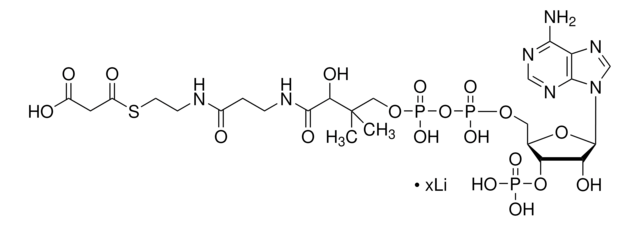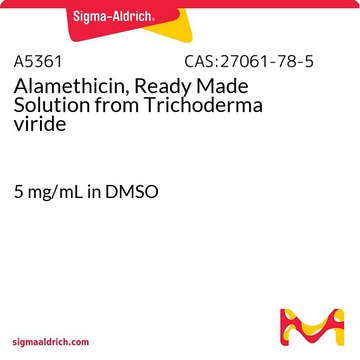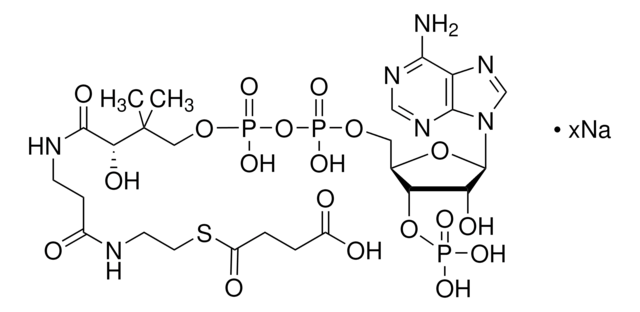추천 제품
일반 설명
Acetyl-CoA Carboxylase 1 (ACACA) is mapped to human chromosome 17q12. It is majorly expressed in liver and adipose tissue. ACACA has biotin carboxylase (BC), biotin carboxyl carrier protein (BCCP) and carboxyl transferase (CT) domains and an additional interaction domain. (BT) A central domain region (CD) connects the BC and CT domains. ACACA is a key regulator of energy balance. The ACACA catalysis is the rate-limiting step in the synthesis of malonyl-CoA and regulation of free fatty acid oxidation. Elevated levels of ACACA contributes to obesity and tumor progression.
Formulation: Solution in Tris-HCl (pH 8), NaCl, Glycerol
애플리케이션
Useful for the study of enzyme kinetics, screening inhibitors, and selectivity profiling.
생화학적/생리학적 작용
Acetyl-CoA Carboxylase (ACC) catalyzes the formation of Malonyl CoA through the irreversible carboxylation of acetyl CoA. ACC is activated by citrate, glutamate, and dicarboxylic acids and negatively regulated by long- and short chain-fatty acyl-CoAs. ACC1 is essential for breast cancer and prostrate cancer cell survival.
Acetyl-CoA Carboxylase (ACC) regulates the metabolism of fatty acids. This enzyme catalzes the formation of Malonyl CoA through the irreversible carboxylation of acetyl CoA. There are two main isoforms of Acetyl-CoA carboxylase expressed in mammals, Acetyl-CoA carboxylase 1 (ACACA) and Acetyl-CoA carboxylase 2 (ACACB). ACACA has broad tissue distribution but is enriched in tissues critical for fatty acid sythesis such as adipose tissue. ACACB is enriched in tissues such as skeletal muscle and heart that are critical for fatty acid oxidation.
The Acetyl-CoA Carboxylase enzymes are activated by citrate, glutamate, and dicarboxylic acids and negatively regulated by long and short chain fatty acyl CoAs. Acetyl-CoA Carboxylase 1 is essential for breast cancer and prostrate cancer cell survival. Because of thier roles in fatty acid metabolism and oxidation, ACACA and ACACB are therapeutic targets for treating obesity and metabolic syndrome disorders.
The Acetyl-CoA Carboxylase enzymes are activated by citrate, glutamate, and dicarboxylic acids and negatively regulated by long and short chain fatty acyl CoAs. Acetyl-CoA Carboxylase 1 is essential for breast cancer and prostrate cancer cell survival. Because of thier roles in fatty acid metabolism and oxidation, ACACA and ACACB are therapeutic targets for treating obesity and metabolic syndrome disorders.
물리적 특성
α transcript variant 1, C-terminal histidine-tagged 270 kDa protein containing amino acids 1-2383 (end)
단위 정의
One unit will cause the conversion of 1 picomole of ATP to ADP per minute at pH 7.4 at 30 °C
제조 메모
Thaw on ice. Upon first thaw, briefly spin tube containing enzyme to recover full content of the tube. Aliquot enzyme into single use aliquots. Store remaining undiluted enzyme in aliquots at -70°C. Note: Enzyme is very sensitive to freeze/thaw cycles.
Storage Class Code
12 - Non Combustible Liquids
WGK
WGK 1
Flash Point (°F)
Not applicable
Flash Point (°C)
Not applicable
가장 최신 버전 중 하나를 선택하세요:
시험 성적서(COA)
Lot/Batch Number
Regulation of acetyl CoA carboxylase and carnitine palmitoyl transferase-1 in rat adipocytes
Zang Y, et al.
Obesity Research, 13(9), 1530-1539 (2005)
Structural basis for regulation of human acetyl-CoA carboxylase
Hunkeler M, et al.
Nature, 558, 470-474 (2018)
Jorgen F P Wojtaszewski et al.
American journal of physiology. Endocrinology and metabolism, 284(4), E813-E822 (2002-12-19)
The metabolic role of 5'AMP-activated protein kinase (AMPK) in regulation of skeletal muscle metabolism in humans is unresolved. We measured isoform-specific AMPK activity and beta-acetyl-CoA carboxylase (ACCbeta) Ser(221) phosphorylation and substrate balance in skeletal muscle of eight athletes at rest
Graeme J Gowans et al.
Cell metabolism, 18(4), 556-566 (2013-10-08)
While allosteric activation of AMPK is triggered only by AMP, binding of both ADP and AMP has been reported to promote phosphorylation and inhibit dephosphorylation at Thr172. Because cellular concentrations of ADP and ATP are higher than AMP, it has
Morgan D Fullerton et al.
Nature medicine, 19(12), 1649-1654 (2013-11-05)
The obesity epidemic has led to an increased incidence of nonalcoholic fatty liver disease (NAFLD) and type 2 diabetes. AMP-activated protein kinase (Ampk) regulates energy homeostasis and is activated by cellular stress, hormones and the widely prescribed type 2 diabetes
문서
Information on fatty acid synthesis and metabolism in cancer cells. Learn how proliferatively active cells require fatty acids for functions such as membrane generation, protein modification, and bioenergetic requirements. These fatty acids are derived either from dietary sources or are synthesized by the cell.
자사의 과학자팀은 생명 과학, 재료 과학, 화학 합성, 크로마토그래피, 분석 및 기타 많은 영역을 포함한 모든 과학 분야에 경험이 있습니다..
고객지원팀으로 연락바랍니다.








